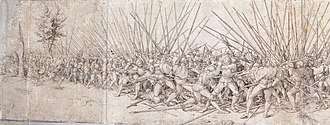Push of pike
The push of pike was a particular feature of late medieval and Early Modern warfare that occurred when two opposing columns of pikemen (often Swiss mercenaries or German Landsknechte) met and became locked in position along a front of interleaved pikes.


Shoving match
During push of pike, opposing blocks of pikemen would advance with their pikes "charged" horizontally at shoulder level to jab at one another until bodily contact was made. The two sides would then push physically until one or other of them gave way. The push of pike would continue until one of the opposing formations routed or fled, which would generally lead to massive casualties. Each man pressed on the one in front, and so sometimes the formations would crush against each other and many pikemen would have to fight in closer melee combat.[1][2] The rear ranks would sometimes join the fray but their primary role was to add more weight to the push.[3] Aside from getting impaled by enemy pikes, those in the front ranks died from getting crushed or suffocated due to the sheer number of bodies pressing from each side.[4] The Italians referred to this as 'Bad War' after seeing Swiss pikemen become locked in thick combat, where – because both formations refused to back down – both sides lost huge numbers of men in the bloody melee.
There are instances when both sides agree to a break for a short rest then the pikemen resume their clash.[3] Rodeleros along with the Doppelsöldner were used in order to break push of pike engagements. The push of pike played an important role in the English civil war as one-third of the infantry consisted of pikemen. Pikemen often cut down the lengths of their pikes in order to make them more manageable. This habit had on many occasions disastrous consequences as the side with the longest pikes had the advantage during push of pike.[5]
The push of pike was still crucial and decided the outcome of battles from the 14th century up to the early part of the 18th century.[6]
Battles involving push of pike
Anglo-Spanish War (1585–1604):
References
- "Gerards Pike". Archived from the original on 15 July 2014. Retrieved 20 July 2014.
- "Dunbar". Retrieved 20 July 2014.
- Scott, Christopher; Turton, Alan; Gruber von Arni, Eric (2006). Edgehill: The Battle Reinterpreted. South Yorkshire: Pen & Sword Military. p. 113. ISBN 1844151336.
- Nolan, Cathal (2017). The Allure of Battle: A History of How Wars Have Been Won and Lost. Oxford: Oxford University Press. p. 66. ISBN 9780195383782.
- "English Civil War". Retrieved 20 July 2014.
- Curley, Robert (2012). The Science of War: Strategies, Tactics, and Logistics. New York: Britannica Educational Publishing. p. 46. ISBN 9781615307500.
- Oman, Charles (1999). A History of the Art of War in the Sixteenth Century. ISBN 9781853673849.